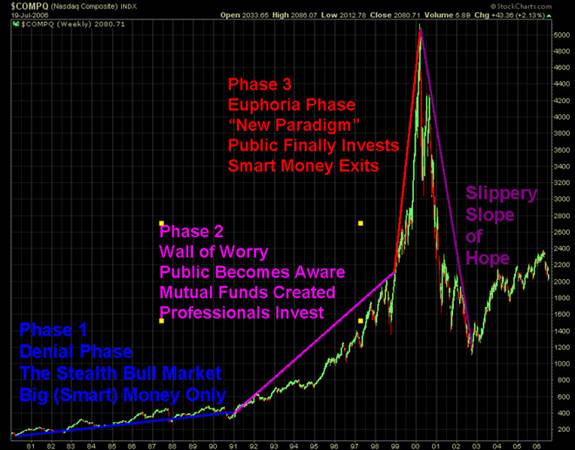Gold Going Mainstream, Time to Buy or Sell?
Commodities / Gold & Silver 2009 Jun 02, 2009 - 09:48 AM GMTBy: Michael_Pollaro
 As Good as Gold, says the Financial Times in a May 8th essay. To quote. “The glistering store of value, unwanted in 1999, is back in fashion.” All one needs to do is “buy and hold.”
As Good as Gold, says the Financial Times in a May 8th essay. To quote. “The glistering store of value, unwanted in 1999, is back in fashion.” All one needs to do is “buy and hold.”
Around 1999, some of Europe’s monetary authorities started selling gold – 3,800 tonnes of it for $56bn. Alas, they started the sales at the bottom of the market. Since then, the gold price has more than tripled. An astute evil-doer who snapped up all those ingots would have made $52bn from the central banks.
Since the start of the financial crisis in August 2007, its price has risen by 35 per cent. The metal is a hedge against the chance that the world’s central banks will prove no better at preventing high inflation than they were at choosing when to sell gold
http://www.ft.com/cms/s/0/99c7813e-3bfa-11de-acbc-00144feabdc0.html
On May 15th, a 13F Filing showed that hedge funds managed by John Paulson held almost 9% of all outstanding GLD (the gold bullion ETF) at the end of March, a position with a market value of around $3 billion. Paulson's funds also owned about 15% of GDX (the gold mining stock ETF), 11% of Anglogold (AU), 4% of Kinross (KGC), and 3% of Goldfields (GFI).
Around the same time we learn that David Einhorn of Greenlight Capital, another well-known hedge fund manager, has accumulated a substantial exposure to gold-related investments.
Then on June 1st, Bloomberg reports:
Northwestern Mutual Life Insurance Co., the third-largest U.S. life insurer by 2008 sales, has bought gold for the first time the company’s 152-year history to hedge against further asset declines.
“Gold just seems to make sense; it’s a store of value,” Chief Executive Officer Edward Zore said in an interview following his comments at a conference hosted by Standard & Poor’s in Brooklyn…
Northwestern Mutual has accumulated about $400 million in gold, and Zore said the price could double or even rise fivefold if the economy continues to weaken…
“The downside risk is limited, but the upside is large,” Zore said. “We have stocks in our portfolio that lost 95 percent.” Gold “is not going down to $90.”
http://www.bloomberg.com/apps/news?pid=20601087&sid=ajf0L9wTPq6Y&refer=home
Mainstream papers like the FT singing gold’s praise. Then, smart institutional money, of the likes of Paulson and Einhorn, moving into gold. And finally, conservative minded life insurance companies like Northwestern Mutual doing the same. It must be time to sell gold, right? Or, is this indicative of a changing mindset among the establishment to gold?
Bill Fleckenstein, proprietor of Fleckenstein Capital, notes:
According to a story in Commodity Online, gold comprised just 5% of world financial assets in 2008; whereas in 1982 gold comprised 22% of world financial assets. As I've noted before, when I first got into the investment business 30 years ago, it was considered prudent to have at least 5-10% of one's assets in gold. Of course, that asset allocation doesn't take into consideration the general disdain that central banks now have for the purchasing power of any of their currencies, which ought to exacerbate today's demand for gold.
Looked at differently, according to the World Gold Council (and John Hathaway), if global pension funds decided to increase their exposure by about 1.2%, it would require more than 44,000 metric tons, or roughly 27% of all the gold that's ever been mined.
As I noted when the FT changed its tune about gold (May 09: "As Good As Gold"), I think the big story is going to be the establishment-types who -- to potentially hew to the fashionable status of allotting 5-10% of one's financial assets in gold-- ultimately chase the price much higher as they build their positions. And, if the Chinese central bank decides to do that, they have a long ways to go from their base of just under 2%.
Bull markets have 3 phases, graphically depicted below:

The smart money moves in early, the institutional money next and finally the dumb money, the retail money, last. Phase 3, when the smart money sells to the dumb money, is where fortunes are made.
Gold bottomed at $252 in 1999. Smart money has taken it to today’s $980. Big gains, yes, but institutional money is only now moving in. If gold is the real deal, and I believe it is, an explosive Phase 3 still awaits.
As Fleckenstein notes, at the top of the last bull market in gold, gold comprised 22% of the world’s assets. Today it’s a mere 5%.
Perhaps, we ain’t seen nothing yet!
By Michael Pollaro
Email: jmpollaro@optonline.net
I am a retired Investment Banking professional, must recently Chief Operating Officer for the Bank's Equity Trading Division. I am also a passionate free market economist in the Austrian School tradition and private investor
Copyright © 2009 Michael Pollaro - All Rights Reserved
Disclaimer: The above is a matter of opinion provided for general information purposes only and is not intended as investment advice. Information and analysis above are derived from sources and utilising methods believed to be reliable, but we cannot accept responsibility for any losses you may incur as a result of this analysis. Individuals should consult with their personal financial advisors.
Michael Pollaro Archive |
© 2005-2022 http://www.MarketOracle.co.uk - The Market Oracle is a FREE Daily Financial Markets Analysis & Forecasting online publication.



